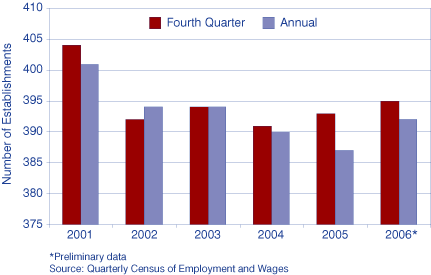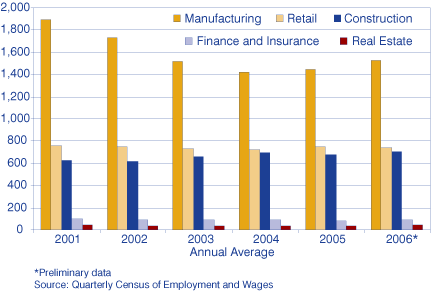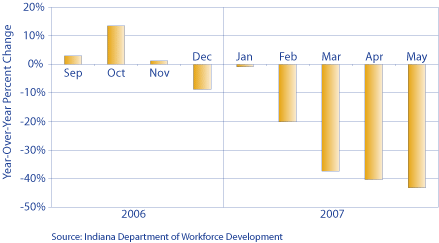Casino Impact on Orange County's Labor Market—Early Evidence
One of the frequently cited reasons for rural casino development is the number of jobs generated for local residents. The release of the year-end 2006 Quarterly Census of Employment and Wages (QCEW) data by the Bureau of Labor Statistics and the November 2006 opening of the French Lick casino provide an opportunity for a preliminary analysis of employment activity associated with the casino's opening and its first months of operation.
Jobs
The most recent QCEW data provide sector employment information up to December 2006 and should capture any increases (or decreases) in total payroll employment associated with the start-up and opening of the new casino.
Preliminary data indicate that approximately 1,005 jobs were added in Orange County from the fourth quarter of 2005 to the fourth quarter of 2006. A closer look at the 2006 monthly data reveals that the number of jobs increased by approximately 300 in September 2006 (two months prior to the official opening), and measurable increases occurred during the last quarter of 2006. Altogether, total payrolls increased by 15.5 percent from fourth quarter 2005 to the fourth quarter of 2006 (see Figure 1).
Figure 1: Orange County Payroll Employment

Businesses
Advocates of casino development also tout the number of new business establishments a new rural casino is expected to generate. Preliminary data indicate that the casino's initial opening had a negligible impact on the number of new establishments (see Figure 2). Five additional establishments were added to Orange County from 2005 to 2006. It should be noted that these are initial data and correspond only to the opening of the casino. Additional time is needed to gain a more accurate measure of the impact on the number of new establishments. QCEW data for December 2007 will not be available until 2008; hence, analyzing the first full year of impact from casino operations cannot be done for some time.
Figure 2: Number of Orange County Businesses

Wages
The 15.6 percent increase in employment led to a 16.5 percent increase in total wages from 2005:4 to 2006:4. Year-over-year average weekly wages for the fourth quarter increased less than 1 percent, however. The annual increase (2005 to 2006) in the average weekly wage increased by 5.6 percent, and the average annual pay (2005 to 2006) increased by 5.5 percent, representing the largest increase in five years (see Figure 3).
Figure 3: Percent Change in Orange County Wages, 2001 to 2006

Sector Performance
The addition of more than 1,000 jobs can be traced entirely to the casino project. Leisure and hospitality sector data show that 1,115 jobs were added surrounding the casino's opening (see Figure 4). Absent the casino, Orange County could have possibly lost approximately 100 jobs, which is consistent with recent trends.
Figure 4: Orange County Leisure and Hospitality Employment

Other sectors observed small gains. Construction, manufacturing, finance and insurance, and real estate all saw small gains in employment. As of year-end 2006, retail showed a small decrease in jobs (see Figure 5).
Figure 5: Orange County Employment in Selected Industries, 2001 to 2006

The passage of 2007 will give analysts an indication of sector employment changes following the one year opening of the French Lick casino and hotel. The summer 2007 opening of the West Baden Resort hotel is expected to generate additional jobs in the leisure and hospitality sector, and other developments are also in progress. The impact of both hotels on other sectors will become more apparent with a full year of 2007 data.
Labor Force Activity
The BLS releases Local Area Unemployment Statistics (LAUS) monthly data on labor force, employment and unemployment rates. Unlike the QCEW data, LAUS data are timely and provide an opportunity to observe recent labor market activity. QCEW data track the location of the jobs, but LAUS data follow the geographic residence of the individual. For example, an additional job may be created in Orange County (i.e., a new job associated with the casino and located in Orange County), and that job will be counted in Orange County's QCEW data. However, these additional jobs may or may not be held by county residents.
A person is counted as a member of the labor force in the county where he or she lives. An employed individual living in Orange County would be counted as employed and a member of the Orange County labor force, regardless of where the individual worked. If the resident commuted to a job in Lawrence County, she would still be counted as a member of the Orange County labor force. Thus, her job would be counted in the Lawrence County QCEW data, but she would show up as part of the Orange County labor force in the LAUS data.
Focusing on both QCEW and LAUS data allow the analyst to draw inferences regarding the residency of individuals holding the additional jobs associated with the casino. Year-over-year fourth quarter data (2005:4 to 2006:4) show the labor force (Orange County LAUS data) increased by 8.2 percent (774) and the number of employed increased 9 percent (794) (see Table 1). Again, the QCEW data track jobs located in Orange County and the LAUS data track employment of Orange County residents. Hence, the 15.6 percent increase of approximately 1,000 jobs in the QCEW data implies that a majority of these jobs initially accrued to Orange County residents.
Table 1: Orange County Labor Force Statistics
| Time Period | Labor Force Percent Change | Employed Percent Change | Unemployed Percent Change |
| 2005:4 to 2006:4 | 8.2% | 9.0% | -3.2% |
| Four-Year Average Percent Change | 0.6% | -1.8% | -1.8% |
| Note: Four years are included to exclude the effects of 2001 recession | |||
| November 2006 to July 2007 | -8.7% | -8.5% | -12.3% |
| Five-Year Average Percent Change | 2.9% | 3.1% | 0.2% |
| July 2006 to July 2007 | -3.6% | -2.2% | -22.7% |
| Five-Year Average Percent Change | 0.1% | 0.1% | 0.8% |
Following the initial November 2006 opening, there has been a gradual decline in the size of the Orange County labor force. The Orange County labor force declined by 8.7 percent from November 2006 to July 2007. The 8.7 percent decline compares to a five-year November to July average change of a positive 2.9 percent. The 8.7 percent decline is lower than the previous five-year trend and points to an apparent change in the Orange County labor force since the casino opened.
Seasonality does impact the size of the labor force throughout the year, and perhaps a portion of this decline may be attributed to seasonality. Focusing on the change in the labor force from July 2006 to July 2007, a decrease of 3.6 percent (347) is observed. Similarly, year-over-year July data also indicate a decline in employment of 2.2 percent (194). The five-year average of July-to-July changes in both labor force and employment is a positive 0.1 percent.
Unemployment Insurance Claims
Unemployment claims provide additional insight on labor market activity in Orange County. Unemployment claims are available monthly from the Indiana Department of Workforce Development. The data indicate significant declines in unemployment claims for Orange County. Declines in year-over-year unemployment claims began in December 2006 and the largest declines occurred throughout 2007. The highest decline for unemployment insurance claims occurred in May with a 43 percent decline from May 2006 (see Figure 6).
Figure 6: Percent Change In Orange County Unemployment Insurance Claims

Concluding Thoughts
Preliminary data indicate that the casino project has generated more than 1,000 jobs in Orange County. Total wages are up and county residents are also seeing an increase in average annual wages. LAUS data indicate that these jobs led to an initial increase in the labor force, as well as the number of employed Orange County residents. After the casino opening, subsequent LAUS data point to a decline in the Orange County labor force and the number of employed Orange County residents. Unemployment claims show large decreases throughout 2007. Additional 2007 data will allow for more definitive conclusions on the impact of the French Lick casino on the Orange County labor market.
Uric Dufrene
Sanders Chair in Business, Indiana University Southeast and
Brenda Swartz
Director, Regional Economic Development Resource Center, Indiana University Southeast
